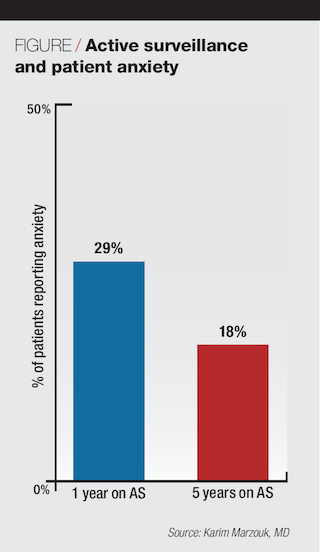Article
Active surveillance linked with moderate anxiety
Author(s):
Men undergoing active surveillance for prostate cancer experienced levels of anxiety that were moderate, but that decreased over time, according to results of a large, prospective cohort study presented at the 2017 Society of Urologic Oncology annual meeting in Washington.
Men undergoing active surveillance for prostate cancer experienced levels of anxiety that were moderate, but that decreased over time, according to results of a large, prospective cohort study presented at the 2017 Society of Urologic Oncology annual meeting in Washington.
These findings should be taken into consideration when counseling men on active surveillance, said first author Karim Marzouk, MD, urologic oncology fellow at Memorial Sloan Kettering Cancer Center, New York.
“I think what we need to stress is that this entity exists-the anxiety is real-but at the same time, we just need to make sure patients and their family members are aware” that it will likely recede with longer follow-up, Dr. Marzouk said in an interview with Urology Times.
Patients might also be reassured to know that active surveillance entails very close follow-up over time, Dr. Marzouk added.
While acceptance of active surveillance is growing, few data exist on anxiety associated with the approach and how it might impact management decisions. Some previous studies suggest an estimated 5% to 13% of patients will terminate active surveillance and opt for treatment due to cancer-related anxiety, according to Dr. Marzouk.
Read: PCa-specific mortality not affected by comorbidity
Dr. Marzouk presented the study, which included 463 patients enrolled in active surveillance from March 2000 through January 2016.
Next: Disease-specific questions asked
Disease-specific questions asked

At multiple time points throughout follow-up, patients responded to a modified version of an anxiety scale designed to be specific to the disease, which included questions such as, “Do you have any distressing thoughts or worries about your prostate cancer?”
Also see: BMI predicts post-RP metastasis, prostate cancer mortality
Those disease-specific questions set this study apart from some earlier investigations that used more general measures of anxiety, according to Dr. Marzouk.
The authors classified any “agree” or “strongly agree” responses to those questions as prostate cancer-associated anxiety.
“We're using very liberal definitions here, but by doing so, we're trying to kind of quantify and capture what is the underlying anxiety that is happening with active surveillance for prostate cancer,” Dr. Marzouk said.
By 1 year after active surveillance had begun, roughly 29% of patients reported some form of anxiety, according to Dr. Marzouk. By year 5, that figure decreased to approximately 18% of patients.
The risk of anxiety decreased with time on active surveillance (odds ratio [OR]=0.87; 95% CI: 0.79-0.95; p=.003), further analysis revealed.
The median age of the patients was 61 years, median PSA at diagnosis was 4.4 ng/mL, and 95% had Gleason 6 disease, according to the report.
Men who reported higher overall health scores on a 10-point Likert scale had lower levels of anxiety throughout the duration of active surveillance, investigators further reported (OR, 0.83; 95% CI: 0.74-0.93; p=.001).
That finding echoes previous studies suggesting that men with poor health status or comorbidities “tend to be a little bit more anxious about their prostate cancer and about surveillance,” said Dr. Marzouk.
No other covariates besides self-reported health status impacted the risk of anxiety in this study, according to the researchers, who also included Behfar Ehdaie MD, MPH, Melissa Assel, MS, and Andrew Vickers, PhD.
More from Urology Times:
Is favorable-risk GG2 prostate Ca suitable for active surveillance?
Top 9 peer-reviewed prostate cancer papers of 2017
Study: Active surveillance uptake remains low
Subscribe to Urology Times to get monthly news from the leading news source for urologists.
Newsletter
Stay current with the latest urology news and practice-changing insights — sign up now for the essential updates every urologist needs.

















